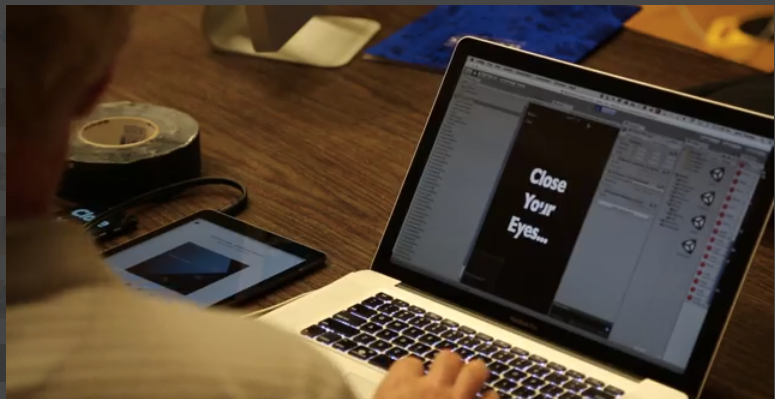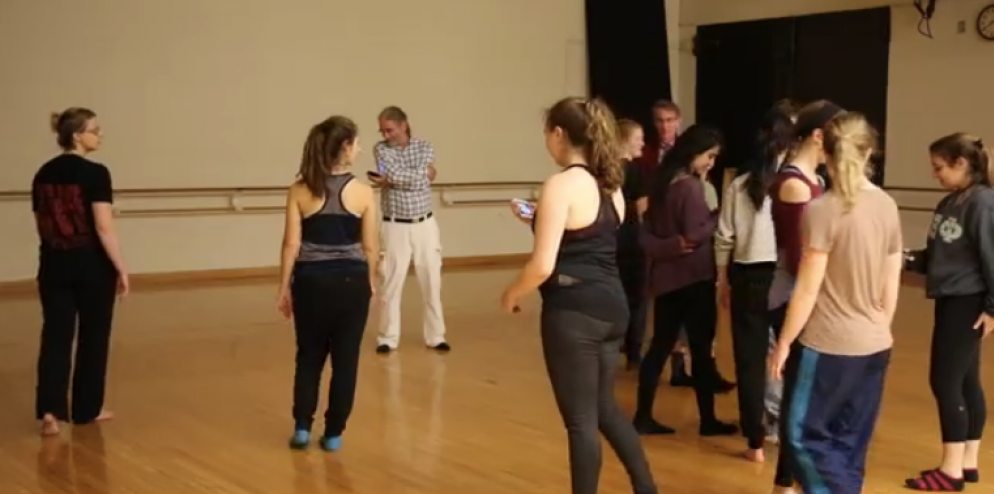On November 13th, students, faculty, and guests participated in a “Dance Technology Mini Faire” in the Dance Rehearsal Room in the Krannert Center for Perming Arts. The half day highlighted current experiments with computer augmented dance performance at the University of Illinois.
Organized by U of I Professor John Toenjes, the program included student projects from a Dance Technology class, an interactive installation from Informatics student Mike Junokas, and an new piece created by Professor David Marchant, of Washington University in St. Louis.
Marchant’s piece, titled “iWe”, used software developed by the U of I Laboratory for Audience Interactive Technology (LAIT), which enabled the choreographer to send messages to the mobile phones to direct five “audience” members who joined the dancers on the floor. I was one of the unrehearsed, non-dancers who participated in this piece.
The dance included dance students who rehearsed the short piece and members of the audience who were invited out onto the floor to participate in the dance. The “civilians” were not rehearsed, but loaded the LAIT app on our phones. We were asked to follow the instructions sent to their phones, to lead us through a simple dance among the dancers.
As the piece progressed, the choreography included a sequence of cues that were delivered with a soft chime to each personal device. We looked at the phone to see the next instruction. Sometimes the instruction was to close our eyes and listen. Sometimes we were supposed to move. Meanwhile, the rehearsed dancers moved and danced amongst the rest of us.
The instructions gradually increased the demands, from simply watching, to coordinated movements, becoming personal and challenging. We were asked to walk up and whisper in the ear of a stranger, and ultimately, to move around and touch the dancers to “make them start and stop”.
As a participant, I found the experience totally different from “watching” a dance performance. I have no recollection of the music — my attention was absorbed trying to do the dance. I wasn’t sure what was coming next, or whether I was “doing it right”, even though I knew it wasn’t a test. When I missed one of cues, I was forced to improvise, and try to guess what the instruction was from the actions of the other folks. As I said, this was not passive watching.

This piece can be seen to come out of Marchant’s continuing interest in mixing dancers and audiences, and in testing notions of privacy and intimacy. It is easy to see that Toenjes’ new software seems to be an ideal tool for creating such experiences, and for experimenting to discover what can be done with such tools.
Choreographer Marchant hiself observed from St. Louis live via Skype, and remarked that it was the first time he had “emailed in” his choreography. Choreographers have “mailed in” dance in the past, but this practice seems certain to become much more common.
Marchant remarked in email:
“t was an intriguing experience to do it that way, from a distance, in my imagination, without knowing for certain if the elements would all synchronize into a coherent and effective experience. I enjoyed seeing it come into a realized form by Skype–another new experience for me–seeing one of my dances for the first time by telecom link.”
LAIT software was recently featured in performances at University of California, Irvine. An earlier version of the LAIT software was used to augment the performance of Kama Begata Nihilum at Krannert Center in February 2014. Kama Begata stood out from most Krannert Center events, because you were not told to “turn off you phone”. Instead, you were invited to ”load the app and participate in the performance”.
Welcome to the 21st Century!
With many years experience creating and performing technologically enhanced dances, Professor Toenjes teaches Dance Technology at the UI. Recently, he has become intrigued by the way people feel attached to their mobile devices, which seem to be an extension of themselves. The LAIT technology enables experiments that bring these devices into dance, improvised movement, and into interactions with an audience.
But his technology is certainly not limited to performing arts. This year the LAIT project is working with collaborators from many fields to explore interaction with “audiences” in public events, lecture halls, museums, and wherever learning happens.
A new version of the LAIT software is due out in early January, and several other perfomances and projects are in the works.
For more information: UI Laboratory for Audience Interactive Technology (LAIT)
Note: Robert McGrath is a collaborator and advisor to the LAIT project.
All images used under the permission of Jeff Carpenter/eDream.








